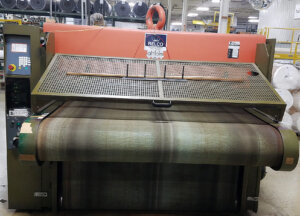Advanced Coating Technologies: What You Need to Know

Let’s explore what coating technology looks like, and how you can make it accessible for yourself. It’s easier than you might think!
What are advanced coating technologies?
Advanced coating technologies vary depending on the project, as well as what you need out of a specific coating. On a very basic level, coating exists to strengthen a product’s surface space. Whereas a product before coating may have been prone to scratching, heat damage, and abrasions and degradation, after coating it’s stronger and more durable. Different coatings offer different specific advantages, but in general coating increases a product’s value on a level that’s both practical and (potentially) financial.
There are many different types of coating technologies, as well as different types of machines that apply the coatings you need. However, one thing you need to know up front is that you don’t necessarily have to buy coating equipment in order to properly benefit from coating technology. You can always work with a third party manufacturing company in order to ensure not only the quality of the technology itself, but the quality of the product output.
When buying your own coating technology, you’re not just making a (permanent) investment in the equipment. You’re also investing in either training existing employees on how to use that equipment, or hiring employees that can. Furthermore, there is no guarantee of the final product’s quality, as you experiment with advanced coating technologies, you may find that you waste more than you gain.
What are different coating methods?
As previously mentioned, a variety of different advanced coating technologies currently exist. There isn’t a “one size fits all” coating technique. Rather, we must find the types of coating technologies that work for our purposes.
Some of the most popular coating methods include:
1. Direct coating
You may have heard of this coating method being referred to as knife over air coating, or knife over roller coating. Both techniques fall under direct coating. We often use these types of coating techniques on fabrics, like airbag fabrics, parachute fabrics, and other impermeable and inflatable fabrics.
2. Direct roll coating
In some spaces, people use the term direct roll coating to group together gravure coating and reverse roll coating. There are, of course, some differences between the two. Gravure coating relies on engraved rollers, demarked with embossed lines or dots. These lines and dots fill with the coating product, which transfers to the substrate slides between the engraved roller and the pressure roller. Reverse roll coating, on the other hand, involves high viscosity liquid coating one side, while double-passing covers both sides. Typically, we use reverse roll coating for stretchy fabrics like knits.
3. Transfer coating
With this process, we apply resin to paper, creating a film that we laminate onto a textile. Often, we use transfer coating to create synthetic leathers, thanks to its thermal protective qualities.
4. Heat lamination
As you may have guessed, this process is heat reliant. We transfer blown films onto different fabrics with heat rollers. The films soften and press together, creating a composite process, sometimes in conjunction with an adhesion system. Usually, we use this to create products for the aerospace field, as well as the medical field. However, we also use it to create recreational products, like sports pads and life jackets.
4. Adhesive lamination
This process is somewhat simpler, using an adhesive to bind film to a fabric. You’ll see this system used to make fabric for blood pressure cuffs.
5. Immersion coating
Call it immersion coating or dip coating; either way, this involves submerging a product in liquid polymer. Typically, the fabric then runs through rollers, which squeezes out the excess polymer.
What industries utilize advanced coating technologies?
As you can see above, a wide variety of industries rely on advanced coating technologies for production. Some of the industries that rely on coating technology and equipment include:
- The medical device industry. You’ll see above that blood pressure cuffs rely upon coating technology—you need the durability that coating offers when manufacturing these products.
- The auto manufacturing industry. When manufacturing equipment and upholstery for vehicles, you’ll inevitably need to utilize advanced coating technologies. Coating makes fabrics not only more durable, but easier to clean.
- The aerospace industry. Believe it or not, whether you’re working with commercial jets or high tech rockets, you’ll likely require the help of different coating
- The clothing and textile industry. Yes, you’ll need coating technologies to take full advantage of clothing manufacturing. Products like faux leather wouldn’t exist without coating technology.
Clearly, there are many reasons why business owners like you utilize advanced coating technologies. While you may feel tempted to handle coating processes all by yourself, this really isn’t necessary. You can get ahead of the game by getting in touch with CTI—we’ll help you plan a system that will confront your coating needs head on. Get in touch with us by calling 419-924-5566, or contacting us here. We’ll help you get your manufacturing process in order, while ensuring the delivery of coating products the way you expect them to be.
- << < Previous Post
- 1
- 2
- ...
- 49
- ...
- 250
- 251 Next Post > >>

